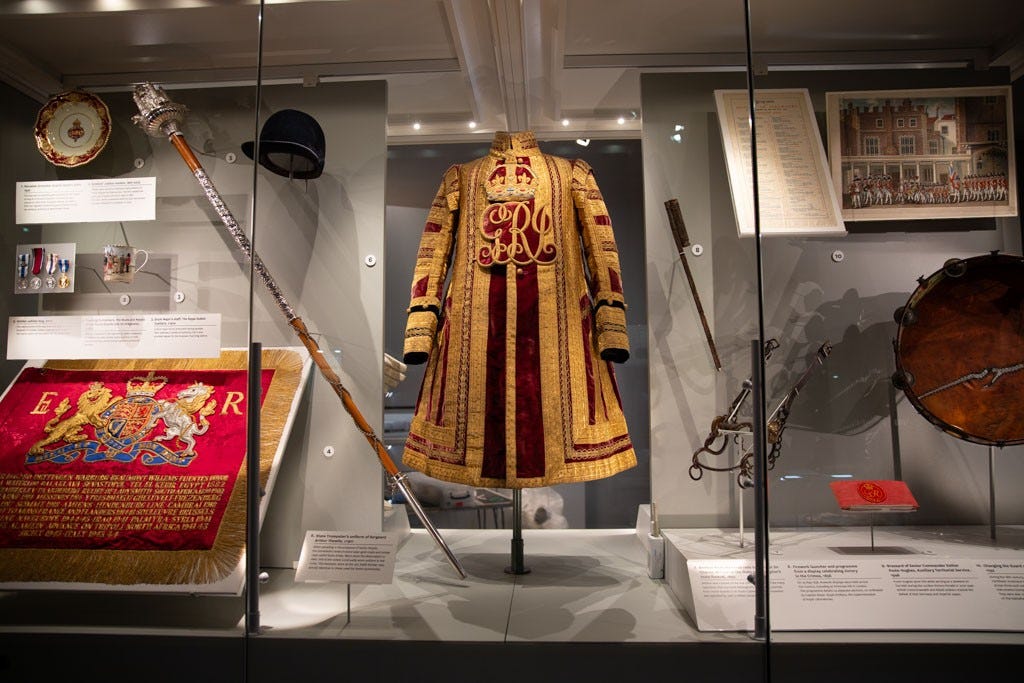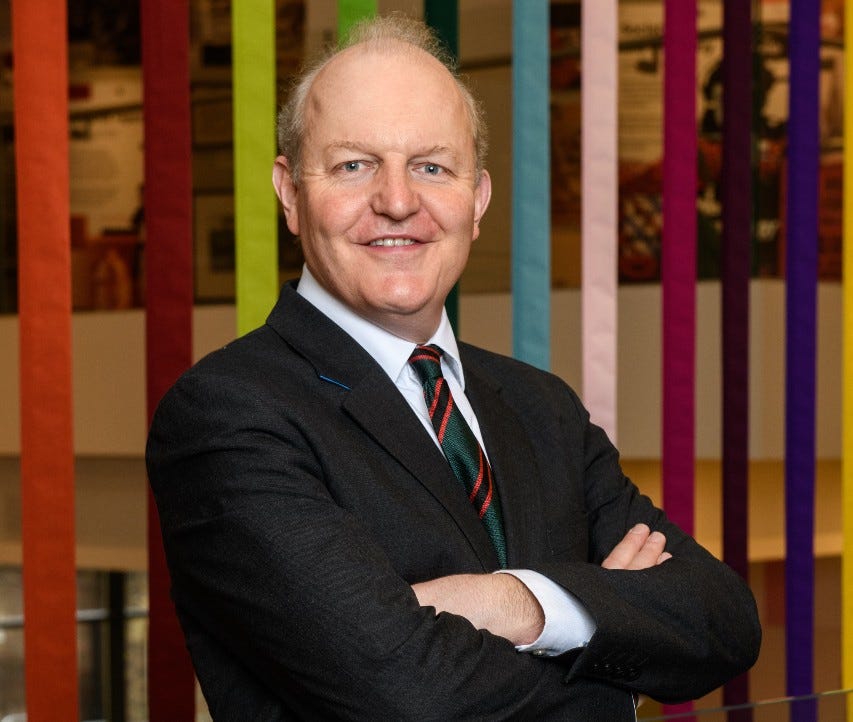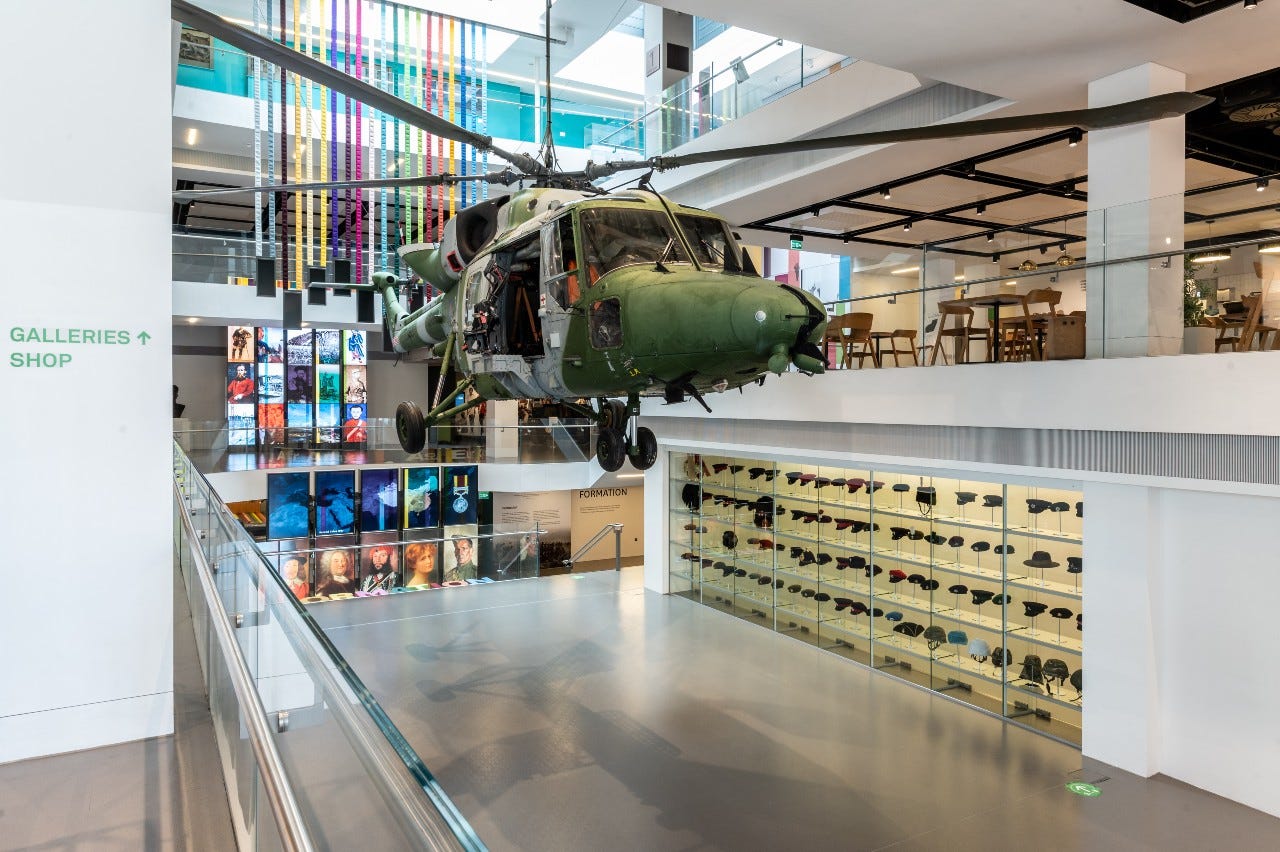INTERVIEW: Director of the National Army Museum
Justin Maciejewski chats about the museum's major gallery refresh, Shakespeare, and why visitor numbers are the biggest challenge
“understanding the soul of the Army is also an important element of our mission”
This is one of your twice-monthly special maxwell museums newsletter editions featuring interviews and recommendations. You get it in addition to your regular weekly news round-ups — keep an eye out for the next one on Friday. Now let’s go to it!
The Hot List
maxwell museums’ curated round up of what’s new to see, do, watch, read and more, From the UK — and around the world.
OUTDOOR ART
🔗 Frieze Sculpture 2023
The Regent’s Park, London
Ahead of October’s Frieze London, the now annual transformation of one of London’s best parks into an outdoor art gallery is back once more. Work by 21 international sculptors, all curated by Fatoş Üstek, can now be seen and enjoyed in the open air. Most eye-catching/disturbing is Tony Matelli's Sleepwalker. Until 29 October. Free.
NEW DOCUMENTARY
🔗 Picasso: The Beauty and the Beast
BBC
This new three-part series traces the many contradictions of one of the world’s most famous artist. Curators, critics and artists comment on Picasso’s craft, while authors, journalists, psychotherapists and family members illuminate psychological and emotional subtexts. A “challenging and valuable screen retrospective” according to the Financial Times. On BBC2 from September 21 at 21:00
NEW EXHIBITION
🔗 Yinka Shonibare CBE: Ritual Ecstasy of the Modern
Cristea Roberts Gallery, London
New collaged prints and never-before-seen sculptures of African ritual masks are unveiled in Shonibare’s first solo exhibition with Cristea Roberts Gallery. The new pieces are seen alongside earlier works featuring the motif of the all-American cowboy and symbols of the British Empire, showing the artist’s evolving printmaking practice. From Friday, until 4 November. Free
EVENING EVENT
🔗 Late at Tate
Tate St Ives
Mark the end of summer with a late night soiree at Tate’s seaside branch in Cornwall. This one celebrates the vibrant Moroccan ‘new wave’ of current exhibition The Casablanca Art School, with drop-in activities, live music sets, talks and films, which you can enjoy alongside Moroccan street-food and drinks on the café terrace. Friday 22 September, 18:30
NEW EXHIBITION
🔗 Manet/Degas
Metropolitan Museum of Art, New York City
A major show examining the close and sometimes tumultuous relationship between Édouard Manet and Edgar Degas. Born only two years apart, they were friends, rivals, and, at times, antagonists who worked to define modern painting in France. Presenting their work side by side, this exhibition investigates how their artistic objectives and approaches both overlapped and diverged. Opens Sunday 24 September
The Big Interview
The story of Britain is inextricably tied to the story of its Army. From the Empire to the economy — via culture, fashion, language and more — the Army has shaped these islands’ history perhaps like no where else. So for England’s national museum on the subject, that’s a big responsibility.
The National Army Museum (NAM) was established by Royal Charter in 1960 to collect, preserve, and exhibit objects and records relating to the forces of the British Army and of the Commonwealth. It opened in Chelsea in west London in 1971. In 2014, it closed for a three-year £24 million redevelopment. Yet in early 2022 — just five years later — it began a process to overhaul its permanent galleries once more.
This work is nearing its end, and the final major milestone was completed this week when the museum’s new Army at Home gallery opened. Next month, a new temporary exhibition will also open, examining war through the eyes and work of William Shakespeare.
So to get the lowdown on an exciting few weeks for NAM — and to find out more about the reasons for the refresh work — I’ve caught up with the museum’s Director, Justin Maciejewski.
A former brigadier and Iraq war veteran, Justin took up the role in 2018. In our chat, we also covered the reasons why there are huge numbers of military museums in the UK, the challenges for the coming year as he sees them, and the story behind using a handwritten note from the Prime Minister in their new exhibition.
***
Hello Justin. You’ve this week opened a refreshed permanent gallery all about the Army’s role ‘at home.’ What can visitors expect?
Our newly refreshed gallery showcases the breadth of the Army’s role across the British Isles: how soldiers have shaped communities, their role in public ceremonies and in times of emergency, and their contribution to British identity.
There are hundreds of amazing objects and artworks dating all the way back to the 1600s, and many that have never been on public display. We’re proud to be able to showcase the George Cross awarded posthumously to Henry Herbert Reed in at the height of the Second World War in 1941, for his utterly selfless courage saving a comrades life when seriously injured himself.
This is the latest stage of a two-year refresh of all the permanent galleries at the museum. Give us a sense of the scale of what you have achieved so far?
I’m incredibly proud of our team. Both during the Covid closure and afterwards, they’ve worked hard to make the galleries the best that they can be — it has been a real team effort across the museum to take our permanent galleries to the next level.
As a result, there are over 50% more objects on display than when we reopened after a major refurbishment project six years ago. What’s even more remarkable is that we’ve been able to achieve this without special funding, by using the infrastructure developed during the 2017 refurbishment and by working collaboratively to harness our in-house expertise and skills.
Why was this the refresh necessary, especially only a few years after the museum reopened following a full redevelopment?
The idea was always to create adaptable spaces that could be refreshed on a rolling basis. Thanks to this flexibility, we have been able to collect and respond to feedback from our visitors since reopening and have built this into our plans to improve the experience onsite.
We’ve adopted a new approach which provides visitors with a more chronological approach, taking visitors through the main historic roles of the Army, telling the stories of our soldiers across the world and down the centuries right up to the present day.
You’ll also be opening an exhibition next month on Shakespeare’s connection to war and how his plays have influenced our understanding of conflict. What are some of the highlight objects?
Supporting new research is really important to us at the National Army Museum, so we were delighted to work with experts Dr Amy Lidster and Professor Sonia Massai to produce Shakespeare and War. It brings thought-provoking perspectives to such familiar plays, and it sheds new light on many items from our collection, such as a copy of Shakespeare’s Complete Works which was given to wounded soldiers in the First World War.
Looking further back, I particularly like the wonderful prints and political sketches produced in the late 18th and 19th century which draw on Shakespeare to comment on military events. And discovering that a Shakespeare play had been performed in Ukraine during the Russian invasion was certainly sobering.
And how did you get the handwritten quote from the Prime Minister?
Just as we were putting the finishing touches to the exhibition design, Rishi Sunak visited Hiroshima, where the first nuclear bomb was dropped during the Second World War. He left a note in the visitor book at the museum there which quoted Shakespeare — ‘give sorrow words’ — but also reflected on how words can’t always fully express the impact of conflict. That’s certainly true for soldiers. It felt like a fitting way to end the exhibition, so we asked No. 10 politely for permission to use it!
— Donate to support future editions of this newsletter — and help keep it free to read!
You had a 27-year career in the British Army. What experiences and skills have you brought from those years to your role running a national museum?
Of course there are plenty of transferrable skills from my Army experience, and from my six years as a Consultant with McKinsey & Company, that have been so integral to leading a large an organisation like the National Army Museum. But understanding the soul of the Army is also an important element of our mission.
We’re very fortunate to receive financial support from the Army, but we’re also an independent museum that cares for a national collection. That means we can explore every aspect of this rich, complex and sometimes challenging history and heritage through our wonderful collection of objects, archive and art. Having empathy for soldiers and their experiences is an important part of doing that effectively.
As you mention, your main source of funding is via the British Army and the Ministry of Defence. But what are the other sources of funding?
We have a growing commercial offer – the National Army Museum is a fantastic venue to hire for corporate and private events, we have a great shop and cafe, and a very popular children’s soft play facility.
But like every Museum we need to make sure we are entrepreneurial and imaginative when it comes to new revenue streams and fundraising, so we ensure we are investing in and investigating new sources of support.
There are dozens of military museums across the UK. Do you think they get the recognition they deserve?
Traditionally, the Regiments were seen as the guardians of the Army’s history and heritage. It wasn’t until 1960 that a national museum was established here in Chelsea in west London. So we’re lucky in this country to have around 150 regimental and corps museums, in every corner of the UK.
In fact, military museums are second only to art galleries in terms of total visitor numbers. It can be hard to maintain what are often quite small venues that rely on volunteers. We already provide professional support and development to the regimental network, and we’re looking forward to finding more ways to help them tell their soldiers’ stories.
What do you think the biggest challenge will be for the National Army Museum in the coming year?
We want to attract more visitors through the doors. Like many other London museums, numbers were slow to return to pre-covid levels but we are now seeing visitors return, and attracting people back is a big priority.
But our work isn’t just confined to the galleries in Chelsea. We’re doing lots of work with our collection, we’re investing in research, and we want to connect with visitors online as well as onsite. It’s an exciting time!
Finally, as usual it's a packed autumn for the UK’s museum and galleries. What other exhibitions are you looking forward to seeing?
I love museums and galleries and my highlight visit so far this year was to the Saint Francis of Assisi exhibition at the National Gallery. Looking forward to the autumn, I will be visiting my local gallery, the Dulwich Picture Gallery where I am a member. At the end of September they are opening a major exhibition on Reubens & Women, and I can’t wait to visit with my family.
The National Army Museum’s new Army at Home gallery is open now. Shakespeare and War opens on 6 October. Entry to both is free. The museum also co-hosts The Chelsea History Festival from 26 September to 1 October.
Recommended reading
🔗 | The London look: 10 fashion exhibitions in the capital — The Guardian
🔗 | Ahead of a major National Gallery exhibition, here’s how Frans Hals taught the world to smile — The Telegraph
🔗 | ‘I wake up happy! I’m singing all day’: Marina Abramović on pain, love – and her recent brush with death as she opens her Royal Academy exhibition — The Observer






